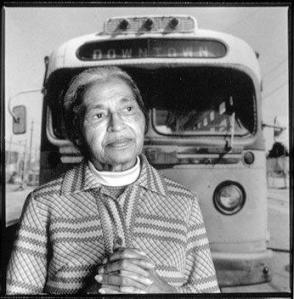 My last post, regarding using stories to inspire movements by creating dissonance in people’s minds, created a lot of commentary.
My last post, regarding using stories to inspire movements by creating dissonance in people’s minds, created a lot of commentary. Here’s what I’ve heard:
"How exactly do you create the uncertainty that makes for a provocative moral? Why does uncertainty make people act? Perhaps this can work for a social movement, but not for an organization."
I think it’s time for a case study.
There is one story, which is credited for starting a social movement that every American knows. It’s the story of an innocent seamstress in Montgomery, Alabama who was too tired to give up her seat on the bus to a white passenger and was consequently arrested. Rosa Parks’ story inspired the black citizens of Montgomery to boycott the bus system, which went out of business within a year, and ultimately compelled the Supreme Court to rule that segregated busing was illegal.
This story became a rallying cry of the civil rights movement and still permeates our culture to this day as a symbol of the effect one, ordinary person can have on society. However, the story, as it is recounted, is not entirely true. Rosa Parks was no innocent victim or ordinary person. She was in fact a long time activist and NAACP member, and her refusal to get up had nothing to do with tired feet. It was completely premeditated by her and the NAACP leadership that put her up to it. They had planned to use Claudette Colvin as the poster child for this event, but abandoned it when she became pregnant.
Why pick Rosa Parks? She was the perfect fit for the lead role in this story. A middle-aged, married, church-going, black woman would create just the right dissonance – the quintessential ordinary person acting extraordinarily.
This event and the subsequent movement it inspired, was staged by an organization. It was not the impulsive, unbridled movement as it’s framed to be (nor are many other movements). I therefore believe the argument that organizations are incapable of producing movements akin to those of organic origins does not hold water. It’s just a matter of how the story is framed.
So why did the NAACP need Rosa Parks? Why did the story have to be about an ordinary person rather than a known hero? Because it was necessary to create the uncertainty (dissonance) required to make others act.
Stories, used properly, raise more questions than they answer. Who is this Rosa Parks? What made this ordinary woman act so out of character? Am I capable of that? What’s going on in Alabama that’s making ordinary people riot? Is there something I should be doing?
If Martin Luther King Jr. had been on that bus no one would have been surprised. It would have been completely rational. When people use their rational brains they’re less likely to act. If you activate their “reptilian brain” or their emotional brain, they move. The same principle is applied to war propaganda. If you tell a story that gets people thinking rationally about the realities of war are they likely to hop into a trench?
Lastly, the NAACP needed Rosa Parks because people don’t respond to organizations…they respond to people. Companies and organizations are undefined and soulless...at least until they take on a personality of their own (read: brand).
Give your organization personality. Are you raising questions or just providing answers? Don’t be afraid to create uncertainty. If people are going to connect with your cause they must see the dissonance between the world as they see it and the injustice that you’re fighting, rather than an abstract “we’re fighting obesity” type of statement.
For help framing your story go to BRANDEMiX. To join a free webinar on communicating the personality of your organization please RSVP to webinar@brandemix.com.

No comments:
Post a Comment
Note: Only a member of this blog may post a comment.